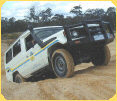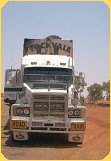|
Outback Info (Private Seiten) © seit 1999
FAUNA OF TASMANIA
Tasmanian Devil (Sarcophilus harrisii )
Prepared by Dr Menna Jones
Honorary Research Associate
School of Zoology, University of Tasmania
The
largest living marsupial carnivore, the Tasmanian devil is the size of a small,
stoutly-built dog. Ideal for their role as Australia's only specialized
mammalian scavenger, devils have a massive head with powerful jaws and strong
teeth. Indeed, their scientific name means flesh (Sarco-) lover (-philus). Males
at 9 kg are larger than females 7 kg; occasionally, males can reach a massive 12
kg. Their jet black fur, unusual for marsupials, is usually marked with white on
the chest and sometimes on the rump. While their black colour, pink ears that
flush purple when they are agitated, and their blood-curdling nocturnal screams
probably earnt them their common name, their true nature, wary though somewhat
belligerent, belies their reputation.
Once occurring across the Australian mainland, devils disappeared after the
arrival of the dingo. They are now restricted to Tasmania (Bass Strait prevented
dingoes from getting here). Devils reach highest abundances in the dry eucalypt
forests and woodlands in northern Tasmania but are found all over the island
state. Although populations have fluctuated this century, their status seems to
be secure.
Devils
emerge from their underground burrows after dark to hunt, moving a steady 8 km a
night with a characteristic loping gait. They forage in dense vegetation but use
tracks for more direct travel. Capable of climbing trees, young devils
particularly catch sleeping birds and eat possums. Most of the diet of adult
devils, however, is made up of wallabies, pademelons and wombats, which are
killed with a tenacious and powerful bite to the head or chest. With their
supreme sense of smell, devils find and scavenge any dead animals, from beached
fish to cows. As specialized scavengers, all parts of a carcass are consumed,
except the largest bones. Large carcasses allow several devils to feed together,
a noisy affair accompanied by much jostling and ritualized displays of mouthfuls
of large teeth. Interactions with other devils are accompanied by a range of
vocalisations, from soft barks and snorts to monotone growling, which escalates
to screams.
While social interactions are frequent in feeding aggregations, devils are
usually solitary. They use several dens in their home range, an area of 8-20
square kilometres which they share with other individuals. The sexes come
together for a short but intense mating season in March during which time they
do not eat. Births occur three weeks later. Females carry up to four young in a
backwards-facing pouch until August, when they are deposited in a grass-lined
den. Young are weaned and independent by February.
The characteristic square footprints of the devil and greyish droppings
containing fur and bones may be seen anywhere in the Tasmanian bush. There is a
good chance of seeing the devils themselves by driving along quiet roads at
night, especially in Mount William, Asbestos Range and Cradle Mountain National
Parks.
|






